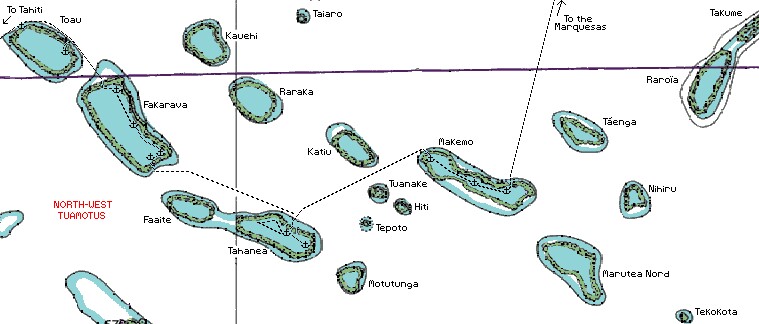
Click on an atoll to go to that page
Map scale: Makemo-Tahanea or Tahanea-Fakarava are each about 50 miles (80km)
Nuku Hiva (Marquesas) to Makemo is about 500 miles (800km), Toau to Tahiti is about 200 miles (350km)
Tuamotus Map
Back to previous page | Tuamotus Newsletters | Toau | Fakarava | Tahanea | Makemo | Marquesas Map

Click on an atoll to go to that page
Map scale: Makemo-Tahanea or Tahanea-Fakarava are each about 50 miles (80km)
Nuku Hiva (Marquesas) to Makemo is about 500 miles (800km), Toau to Tahiti is about 200 miles (350km)
General History of the Tuamotus:
The Tuamotus used to be "real" islands, like the Marquesas. Over time, they grew fringing coral reefs, like the Society Islands (Tahiti) have today. But the Tuamotus are even older than the Societies, and the islands themselves have gradually worn away, leaving only the fringing reefs (which, being alive, continue growing). The waters between motus are thousands of feet deep, but inside the lagoons the water is about 100 ft (30m) deep, with lots of coral heads coming just to the surface.
Most archaeologists believe that the Tuamotus were settled around 850 AD, by Polynesians leaving from the Marquesas. (The other Polynesian islands were likely settled the same way, which would explain their very similar languages and race.) They were an ocean-going people who sailed on large canoes from their small villages (the Tuamotus cannot, in general, support large populations). Beyond that, little is known about the indigenous culture of the Tuamotus.
The atolls of the Tuamotus were discovered by various sailors from Spain, Holland, England, and France, over a period of about 250 years starting in 1520. They were known as the "dangerous archipelago", because their many shallow reefs and strong currents made them very dangerous to navigate, especially since the islands could not be seen from a great distance. In the late 1700's, Tahiti and its neighboring islands (including the Tuamotus) were contested by France and England, with the end result being that the French gained control over the area. In 1842, Tahiti and its surrounds became a French protectorate, and while local rebellions continued for four years, the French have remained in control of the islands ever since. Tahiti and the nearby islands became an official French colony in 1880, and in 1903, all of French Polynesia became one colony, governed from Tahiti.
Over the next 50 years, Tahiti was brought into the modern world, with its soldiers going off to fight in WW1 and WW2, and colonists and manufactured goods arriving from France. However, most of these changes seem to have had little effect on the Tuamotus. In 1957, French Polynesia became an overseas territory of France, and within a few years there were airports, big film crews making a movie of The Bounty, and, most importantly to the Tuamotus, the Centre d'experimentations du Pacifique (CEP), or Pacific Experimentation Center.
Starting in 1963, the CEP chose the southern Tuamotus as the site for French nuclear testing. (Ocelot did not go near this area, nor would we have been permitted to). The local populace was given no choice in the matter, and when their political parties protested, the then French President Charles de Gaulle banned such parties. De Gaulle watched as the first nuclear tests were carried out in 1966, about 600 meters (2,000 feet) up in the atmosphere. Anther 40 atmospheric tests were conducted over the next eight years, and from 1975-91, 134 underground tests. The resulting radiation from the tests remains today, and civilians are not permitted to the affected islands. In addition to the ecological damage, people may have been affected by the radiation, and some of the nearby islands were affected by the tsunami generated when an underground test was conducted too close to the surface of the porous coral atoll.
Although testing was suspended by the French President Francois Mitterand in 1992, in 1995 the newly elected president Jacques Chirac announced there would be eight new tests. There was international shock at this announcement, and when a test was conducted later that year, it had dire consequences for France and French Polynesia, which has never recovered fully from the loss of tourism. Riots broke out around Tahiti, with damage to vehicles, buildings, and the international airport. Nonetheless, six of the eight tests were carried out until, in 1996, President Chirac announced that nuclear testing in the Tuamotus was finished forever.
French Polynesia became more and more autonomous with statutes passed by the
French government in 1977, 1984, 1990, and 1996. In 2000, French Polynesia
became an overseas colony, allowing them to adopt their own laws. Although the
government is located on Tahiti, the Assembly includes representatives from all
of the archipelagos. Today, while France still has many responsibilities,
including defense, the islands use their own currency and fly their own flag
alongside the tricolor French flag. However, France does pay large amounts of
money to French Polynesia, based on a ten year agreement dating from the end of
the nuclear testing in 1996. Effectively, French Polynesians have little need to
work, as the government provides millions of dollars per year and subsidizes all
their standard foods.
Chris Hacking
Back to previous page | Tuamotus Newsletters | Toau | Fakarava | Tahanea | Makemo | Marquesas Map
Top Level: Home | Destinations | Cruising Info | Underwater | Boat Guests | Ocelot | Sue | Jon | Amanda | Chris | Site Map | Make a Comment
|
If our information is useful, you can help by making a donation |
Copyright © 2000‑ Contact: Jon and Sue Hacking -- HackingFamily.com, svOcelot.com. All rights reserved.